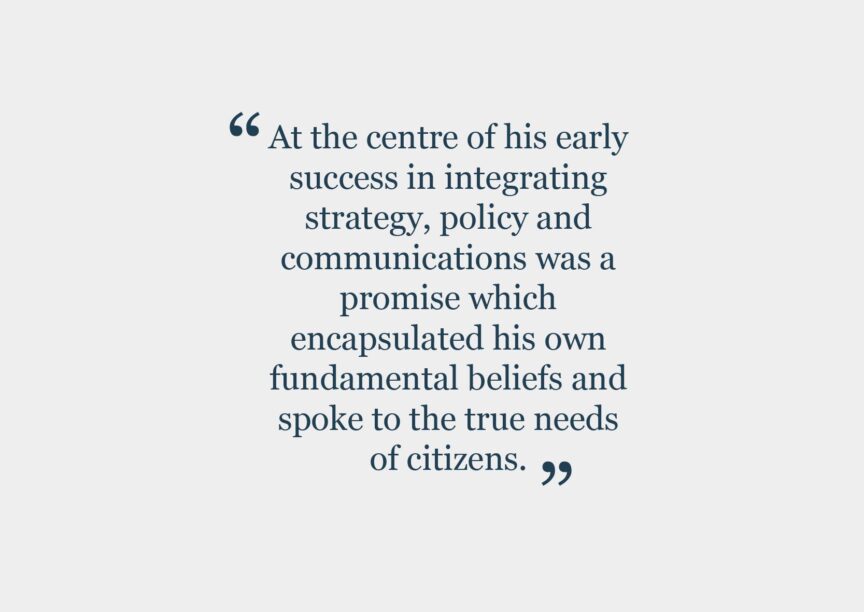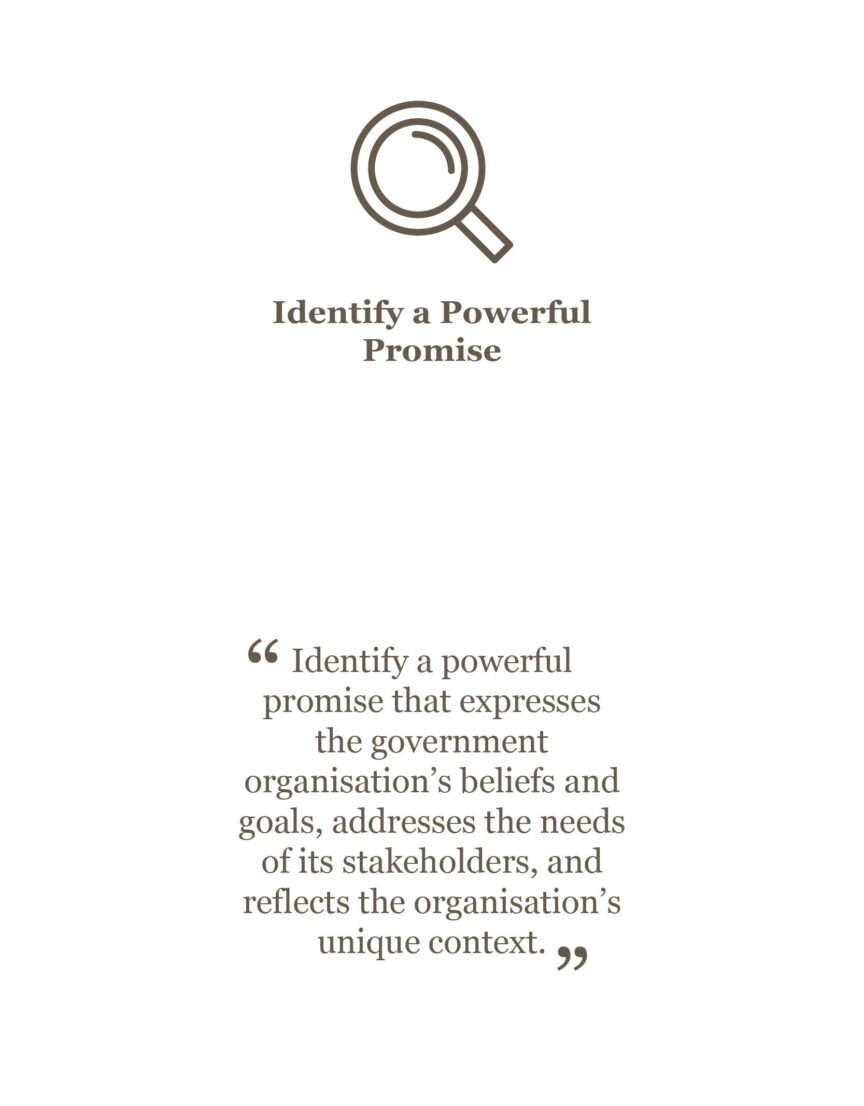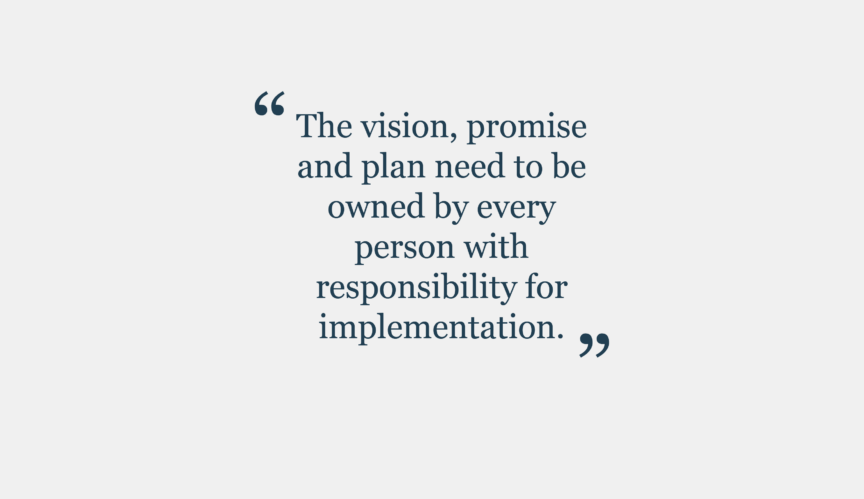The Government Promise System
A better way to deliver impact
By Ryan Coetzee, James Davies and Natasha Ighodaro

At a glance
Integrating strategy, policy and communications is essential for impact, but hard to pull off. A government promise, if it’s purposeful and powerful, can guide the way.
Consulum’s Government Promise System (GPS) acts as a compass for action and communication right across a government organisation. The GPS helps leaders:
- Clarify their core beliefs and translate them into tangible goals
- Craft a statement of purpose and benefit that shows stakeholders “who we are and what you get from us”
- Develop and deliver an integrated agenda that directs the organisation on “what we do and what we say”.

Governments deliver lasting impact when their programmes integrate strategy, policy and communications from conception to implementation. This is the conviction at the core of our work at Consulum – one forged through decades of advising senior public-sector leaders. Yet most governments struggle to achieve that integration, let alone sustain it through their terms of office.
Consider the example of President Emmanuel Macron of France, whose newly formed centrist party, La République en Marche (The Republic on the Move) swept to power in 2017 on a platform of bold, pragmatic solutions and a new style of governing. At the heart of that platform was a strategy of drawing on ideas from different traditions “at the same time”, so transcending the left-versus-right divide. Aligned with that strategy, Macron set out a policy agenda that encompassed innovative, post-ideological solutions to hard problems such as youth unemployment and underachievement in schools. And he integrated communications into his approach, pledging to bring civility to a conflict-ridden political arena: for example, when supporters booed at the mention of his opponents, he said, “that’s not what we do”.
Fast forward to 2023, and Macron’s government has been beset by protests against his pension reforms – protests supported by two thirds of French voters – while Macron’s popularity has languished at around 25 percent. We acknowledge the challenges of governing a large, complex democracy like France, but we believe that Macron’s recent headwinds reflect a failure to sustain the integration of strategy, policy and communications.
Take pensions policy: Macron’s initial reforms, launched in 2019, took a differentiated and flexible approach, based on a points system – true to the pragmatism and innovation of his original platform. The reforms he has since imposed, by contrast, take the much more traditional approach of raising the retirement age across the board. In Macron’s approach to communication, the shift has been notable, too. In the early years of his presidency, his team was careful to discern citizens’ needs and views and involve them in this vision of France’s future; he has since engaged less and directed more. His lack of public support is not surprising.

It’s helpful to view Macron’s story through the lens of a promise. At the centre of his early success in integrating strategy, policy and communications was a promise which encapsulated his own fundamental beliefs and spoke to the true needs of citizens. But once that promise was made, citizens expected it to be upheld through the French government’s policies, communications and daily actions. When it was not, distrust and discord were the result.
To support leaders in driving integration and delivering enduring impact, Consulum has developed what we call the Government Promise System, or GPS – an approach to strategy formulation that enables government organisations to align their policy and communications agenda with a values-based world view. The GPS helps leaders do three things:
- Clarify the core beliefs of their political philosophy and translate those into key goals
- Craft a belief-based promise to their stakeholders – a statement of purpose and benefit that makes it clear “who we are and what you get from us”
- Keep that promise by developing and delivering an integrated agenda, based on rigorous analysis, that guides the organisation on “what we do and what we say”.
In effect, the GPS acts as a compass for action and communication right across the government organisation. When every action a government takes is aligned with its promise, then the aggregated impact is greater than the sum of its parts. Consistency is, in turn, the key ingredient for building trust with stakeholders – and for a communications approach that engages citizens and generates buy-in at a mass scale.

Obstacles on the road to government integration
We developed the GPS because, while working both in and with governments around the world, we found several barriers that, time and again, hamper the integration of strategy, policy and communications. These include:
- Philosophical incoherence. Governments operate from a values-based worldview, sometimes consciously, sometimes less so. Either way, strategy- and policy-making should not simply be outcomes-driven or efficiency-focused. Instead, they should reflect beliefs about the right way to organise society.But it’s hard to achieve philosophical coherence, because government bureaucracies have their own interests, while key leaders in a government don’t always share the same worldview. The easy way out is to paper over such disagreements or fudge an incoherent compromise – but this can be fatal for a government’s strategy.
- Complex, multi-dimensional problems. Government leaders do not have the luxury enjoyed by their counterparts in the private sector, of being able to focus their energy on a limited number of profitable products and target markets. Governments, by their nature, must take the lead in tackling society’s most complex problems, which are typically driven by a wide range of factors. Take the health and social damage caused by drug addiction. It is often a result of economic deprivation in producer countries, organised crime filling the gap prohibition creates, and the complexities of social disintegration and individual human psychology. Simplistic policy solutions, such as declaring a “war on drugs,” rarely make headway against such complexity.
- The challenge of leadership. Few jobs are more difficult than being a government leader. Yet, heads of government and government ministers are often thrust into the role with no prior experience in the executive branch of government. They are confronted by vast, complex challenges which often need to be resolved at lightning speed. They have to win over and sway entrenched interests and bureaucracies while contending with unexpected external shocks and relentless public criticism. Government officials need to work collaboratively with their colleagues in other ministries, all while being aware that they may well find themselves replaced just as they are getting their footing. It is precisely because government leadership is so hard that an integrated approach to strategy, policy and communications is essential.
- Silos, inertia and the difficulties of herding cats. Governments are huge, siloed, uncoordinated and slow-moving – hampering progress on priorities such as investment attraction, job creation and citizen health, which require co-ordinated action across ministries and agencies. Necessary accountability systems often reinforce the problem by encouraging officers to cling to safety and avoid the appearance of failure rather than reach for potential success by trying something new and different. Legacy organisational systems and structures are often dated and inefficient. But changing the system based on “peer benchmarking” of other governments’ policies, which may themselves not be good examples, is unlikely to help. As economist John Maynard Keynes observed: “The difficulty lies not so much in developing new ideas as in escaping from old ones.”

Government communications: the third wheel?
Beyond these barriers, public-sector leaders face a further problem – one that is rooted in mindsets. In most governments, strategy and policy development are respected as high-level, high-status work, while communication is too often regarded as an afterthought. At best, it is seen as a way of delivering basic information to citizens, protecting the reputations of leaders, and winning the public support for decisions that have already been made. At worst it barely happens at all.
In fact, there are two essential roles for communications, both of which require it to be integrated with strategy and policy development from the outset. First, for any government to have legitimacy, citizens must be informed and be able to provide feedback on new actions and policies, both in the planning and implementation phases. Meanwhile, governments need to understand the needs, views and feelings of citizens in order to develop programmes in the first place. Seen in this light, research, consultation, information sharing and feedback on performance are nothing less than foundational to the social contract, to the basic functioning of the modern state.
Second, communication can be a powerful policy tool that helps achieve specific outcomes when it is conceptualised as part of the policy architecture. Obvious examples are in behaviour change, where structural nudges and incentives are magnified by psychologically astute communications. But effective communication can also achieve citizen impact at a strategic level, when leaders create a vision of the future that the majority of citizens want to be part of. This happens most often during times of significant change. The great leaders of history all constructed narratives that, by including citizens in the action, generated a critical mass of buy-in. In the 20th century alone, one thinks of Gandhi, Mandela and Ataturk, to name a few.
Developing – and delivering on – a powerful promise
Consulum has created the GPS framework (see Exhibit) to help governments shape and implement a compelling, distinctive promise – and to avoid the pitfalls of uncoordinated, reactive leadership. In each step of the framework, we work with our clients to help them base their decisions on rigorous analysis and considered thinking.

Step 01.
As noted earlier, is to define the government organisation’s animating beliefs and core goals – which can be broken down into strategic and operational objectives. In our experience, many leaders in governments haven’t put enough thought into examining their beliefs about what constitutes a good life for citizens and a vision for society that can enable it.
Integration requires philosophical clarity. Without it, leaders open themselves to risks that range from getting pulled into short-term populist policies that fail to address long-term needs, to being bullied by colleagues or lobbyists into positions that don’t accord with their values, to being led down the wrong path by technocrats and consultants who put efficiency before any consideration of belief, or simply to operating in an incoherent and contradictory manner.

Step 02.
Identify a powerful promise that expresses the government organisation’s beliefs and goals, addresses the needs of its stakeholders, and reflects the organisation’s unique context.
Our proprietary CAPE analysis provides insight on four key elements:
- Category – determining the relevance of the promise by understanding fundamental trends in the category the organisation operates in. For example, a Ministry of Education would consider global trends in education reform.
- Audience – maximising the desirability of the promise by understanding who the organisation’s key stakeholders are, what they think and feel, and what they want.
- Peers – differentiating the promise by understanding what peers and possible competitors are doing and promising, in order to identify how the organisation might offer something distinctive.
- Entity – ensuring the promise will be credible, by establishing the organisation’s capabilities to deliver on the promise, along with any track record that would lead stakeholders to believe it will deliver in future.
To develop a dynamic, data-rich situation analysis of this kind, we work closely with the senior teams of government organisations – and often advise on how to set up and staff those teams. Indeed, assembling the right strategy team is perhaps the single most important action any government leader can take. A top-level strategy team will know how to integrate strategy, policy and communications and treat them as a seamless whole. As Sun Tzu put it: “Strategy without tactics is the slowest route to victory. Tactics without strategy is the noise before defeat.”
A powerful promise, informed by the CAPE analysis, can underpin a clear, shared vision and strategy for a government. Typically, the promise is an internal-facing statement that provides an organisation and its people with clarity about what it is they believe in and what it is they are doing. For example, the national government of a G20 country that was driving rapid economic reform crafted a promise that positioned it as an attractive investment destination for global investors, as follows:
“Our economy is opening at an unparalleled pace, revealing a world of opportunity for investors. We’re welcoming game-changers to partner with us and realize the unrivalled opportunities unleashed by this transformation.”
This promise has relevance (sizeable deals when investors need them most); desirability (new access to a previously closed-off market), difference (openness to true innovation and partnership), and credibility (a track record of policy reform and infrastructure investment). Those are the litmus tests of any government promise – whether for a national or regional government, or for a state-owned company or entity.
Step 03.
Deliver on the promise and leverage it for impact across policy and regulation, stakeholder engagement (both domestic and international), internal communication and organisational culture change. The outcome of this step is a coherent action plan that is appropriately funded, staffed and phased.
As we’ve emphasised – but it bears repeating – it’s crucial that the plan to deliver on a promise integrates communications into strategy and does not treat it as an afterthought. Standard PR, digital and creative approaches won’t cut it. What’s needed are communications professionals with a horizontal range that takes on board the policy environment and wider political and geopolitical context while contributing to analysis and policy development.
In delivering on the promise, it’s also essential to put a premium on stakeholder management. Leaders should not only rely on their charm and networks, as important as these are; instead, a structured relationship-building programme and formal systems should be put in place to maximize the chance of influencing stakeholders and ensuring coherence and consistency in execution.
Last but not least, government leaders will only succeed in delivering on their promise if they mobilize the people who work in their organisation. Too often government leaders rely on a “send-a-memo” approach to get their own public servants to buy into their agenda. But clarity, coherence and consistency can’t exist only in a PowerPoint presentation, or even in a central Strategy and Impact unit – the vision, promise and plan need to be owned by every person with responsibility for implementation.

How the right promise brings order to chaos: a tale of two governments
Let’s move from theory to practice with two examples. The first illustrates the power that comes from developing and delivering coherent programmes that integrate strategy, policy and communications. The second shows what happens when governments lack an integration culture, and the structured processes to underpin it, and fail to confront contradictions, make trade-offs and ensure the breadth of buy-in required before taking their policies out into the world.
In 2009 a new party took power in the Western Cape province of South Africa and developed a new strategy to position the government and direct its policy and communications activity. The animating value of the new government was “substantive freedom” – the idea that people are best left to direct their own lives but need the opportunity to be able to do so. This approach rejected the idea of a passive citizenry reliant on government largess and required citizens to take responsibility for the opportunities government sought to create. And so the government’s political philosophy created a hard constraint against positioning itself as a delivery agent, even though that’s what a lot of citizens expected and wanted.
That philosophy was then combined with a deep analysis of the economic and social circumstances of people in the Western Cape, the national policy environment, geopolitical trends and an assessment of the government’s capacity to function effectively. The product of that union was a distinctive promise:
“We make progress possible by creating an environment in which people have the right and the opportunity to live lives they value – and take responsibility for using that opportunity.”

The Western Cape Government captured this internal promise in the outward-facing slogan “Better Together” (versus, say, “We Deliver”) – which provided a platform for all government policy development and communications. From there, a strategy and policy agenda was developed to deliver on a set of impact objectives. That agenda had to reflect the promise of opportunity and the requirement of responsibility. It prioritised spending on economic infrastructure, rather than on social goods; created a regulatory framework to empower neighbourhood watches rather than demanding a higher police presence; developed public-private partnerships to make medicine delivery to chronically ill patients more effective, rather than relying on over-stretched health service employees.
Importantly, the Western Cape Government’s communications agenda was designed to deliver on the promise while enabling government initiatives to succeed. For example, when a new school was opened, the communication strategy didn’t simply broadcast the opening of another school in a self-congratulatory fashion but would mobilize parents, teachers, community organisations and government agencies in the area to take responsibility for the security of the school and the welfare of the children.
Underpinning the entire programme was a “transversal management system” which sought to ensure coordination and cooperation between government departments and between the provincial- and local- governments. The clarity, coherence and consistency with which the Western Cape government has been run since 2009 is one of the reasons it outperforms every other provincial government in South Africa on almost every measure and metric – from educational and health outcomes to quality of infrastructure as well as investment and economic growth.

By contrast, consider the story of the “omnishambles” in the UK Treasury that degraded the Conservative Party’s promise of responsible economic stewardship in March 2012, when the Conservative-led coalition government announced its fourth annual budget. In the wake of the 2008 global financial crisis, the government had pledged itself to adopt “fiscally neutral” budgets and a hard rule that new spending measures must be offset by new revenue-raising measures.
What should have been another set-piece demonstration of tough, but necessary, fiscal responsibility, instead sparked backlash from a broad range of constituencies. At the heart of the backlash was a relatively minor new budget announcement labelled by critics the “pasty tax” – subjecting hot pasties and other baked goods to 20% VAT, adding around 50p to the price of a pasty. The move was seen as a betrayal of the government’s promise to protect low-income families and was widely criticised by MPs, the media, and the public.
Within weeks, the Chancellor of the Exchequer, George Osborne, was forced to rescind the pasty tax – which started a domino effect of U-turn pressures. Next to go was the “granny tax”, a proposal to phase out age-related tax allowances to over 65s. This was followed by the “charity tax”, an attempt to cap tax relief for charitable donations at 25% of a person’s income. “Where do the U-turns end?” asked officials in Downing Street as the government’s budget unravelled.
In the corridors of Her Majesty’s Treasury, it was widely acknowledged that the budget measures had veered too far from the Treasury’s overarching strategy. Policy officials, often working in silos, had desperately attempted to raise marginal revenue from wherever possible. The Treasury’s communications team’s eleventh-hour concerns were left unheard, and they were ultimately left unprepared to defend detail and decision-making rationale. Put simply, too many departments and disciplines within the Treasury had operated in silos. And the last-minute nature of the budget process had only exacerbated the issue.
***
Governments exist to deliver impact for their people – in the form of greater prosperity, better education, stronger security and healthier, happier lives. The route to achieving that impact is through integrating strategy, policy and communications. Yet such efforts at integration more often fail than succeed.
What’s needed is a powerful government promise, imbued with purpose, that sustains the focus of the administration and guides its solutions, actions and engagement with citizens.

About the authors
Ryan Coetzee
Ryan was Director of Strategy to the UK Deputy Prime Minister, Head of Strategy and Policy for the government of the Western Cape, a Member of Parliament in South Africa and Director of Strategy for the Britain Stronger in Europe campaign. He has deep, first-hand experience of the personal and professional pressures all leaders experience in the course of their work, as well as knowledge of how best to mitigate these pressures in order to succeed. Ryan is Chief Executive at Consulum.
James Davies
James specialises in government strategy and public-policy formulation. He worked in 10 Downing Street under UK Prime Ministers Gordon Brown and David Cameron and he was Head of Budget Policy at HM Treasury, where he led teams to deliver creative solutions to complex and politically sensitive tax and fiscal-policy challenges. James is Consulum’s Managing Partner.
Natasha Ighodaro
Natasha has led the development of strategy on KSA’s most notable giga-projects, Qiddiya and NEOM. Previously, Natasha held senior strategy roles at J Walter Thompson and Impact BBDO where she implemented brand communication strategies for private and public sector organisations across Europe, the Middle East and Africa. As Head of Strategy and Impact at Consulum, Natasha guides a team of senior strategists in designing transformative programs for governments and state-owned enterprises.
